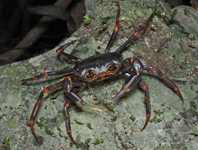Abstract
Hetaerina americana Fabricius, 1798 has a long and irresolute taxonomic history. Several synonyms have been suggested (H. californica Hagen in Selys-Longchamps, 1859, H. basalis Hagen in Selys-Longchamps, 1859, H. texana Walsh, 1863, H. scelerata Walsh, 1863, etc.), related to the variation in the size of the wing spots as well as to the morphology of the male cerci. However, Calvert (1901) suggested that H. americana represents one variable species. Nevertheless, Vega-Sánchez et al. (2019) through a genetic and morphological analysis presented evidence to propose that H. americana represents a species complex. In the present work, we describe a new species that belongs to this complex: H. calverti sp. nov. The morphological characteristics by which males and females of H. calverti differ from H. americana are highlighted. The most important character for the differentiation of males is the shape of the cerci and the size of the individuals (when the two species are in sympatry). In females, the main differences are in the shape of the intersternites and the medio-dorsal carina of the last segment of the abdomen. Some generalities about the biology of the species are presented, including geographical distribution patterns and genetic divergence data. [urn:lsid:zoobank.org:act:F5C329AE-7A00-4979-8A0D-A13D869E54B1]
References
Calvert, P.P. (1901) Odonata. In: Godman, F.D. & Salvin, O. (Eds.), Biologia Centrali-Americana: Isecta Neuroptera Biologia Centrali Americana: Insecta Neuroptera. R.H. Porter & Dulau Co., London, pp. 1–470.
https://doi.org/10.5962/bhl.title.730
Contreras-Garduño, J., Canales-Lazcano, J., Jiménez-Cortés, J.G., Juárez-Valdez, N., Lanz-Mendoza, H. & Córdoba-Aguilar, A. (2008) Spatial and temporal population differences in male density and condition in the American Rubyspot, Hetaerina americana (Insecta: Calopterygidae). Ecological Research, 24, 21–29.
https://doi.org/10.1007/s11284-008-0476-2
Damn, S., Schierwater, B. & Hadrys, H. (2010) An integrative approach to species discovery in odonates. Molecular Ecology, 19, 3881–3893.
https://doi.org/10.1111/j.1365-294X.2010.04720.x
Departamento de Zoología, Instituto de Biología (IBUNAM), Colección Nacional de Insectos (2019) Portal de Datos Abiertos UNAM Colecciones Universitarias. Universidad Nacional Autónoma de Mexico. Mexico. Available from: https://datosabiertos.unam.mx/biodiversidad/ (accessed 11 September 2019)
Fabricius, J.C. (1798) Suplementum entomologiae systemicae. Proft & Storch, Copenhagen, 582 pp.
Garrison, R.W. (1990) A synopsis of the genus Hetaerina with descriptions of four new species (Odonata: Calopterygidae). Transactions of the American Entomological Society, 16, 175–259.
Garrison, R.W., von Ellenrieder, N. & Louton, J.A. (2010) Damselfly genera of the New World, an illustrated and annotated key to the zygoptera. The Johns Hopkins University Press, Baltimore, 3 pp.
Grether, G.F. (1996) Intrasexual competition alone favors a sexually dimorphic ornament in the rubyspot damselfly Hetaerina americana. Evolution, 50, 1949–1957.
https://doi.org/10.1111/j.1558-5646.1996.tb03582.x
Kumar, S., Stecher, G., Li, M., Knyaz, C. & Tamura, K. (2018) MEGA X: Molecular evolutionary genetics analysis across computing platforms. Molecular Biology and Evolution, 35, 1547–1549.
https://doi.org/10.1093/molbev/msy096
Sánchez-Guillén, R.A., Córdoba-Aguilar, A., Cordero-Rivera, A. & Wellenreuther, M. (2014) Genetic divergence predicts reproductive isolation in damselflies. Journal of Evolutionary Biology, 27, 76–87.
https://doi.org/10.1111/jeb.12274
Schneider, C.A., Rasband, W.S. & Eliceiri, K.W. (2012) NIH Image to ImageJ: 25 years of image analysis. Nature Methods, 9, 671–675.
https://doi.org/10.1038/nmeth.2089
Schorr, M. & Paulson, D. (2020) World Odonata list. Slater Museum of Natural History, University of Puget Sound. Available from: https://www.pugetsound.edu/academics/academic-resources/slater-museum/biodiversity-resources/dragonflies/world-odonata-list2/ (accessed 21 March 2020)
Selys-Longchamps, E. de (1853) Synopsis des Caloptérygines. Bulletins de L’Académie Royale Des Sciencies Des Lettres Et Des Beaux-Arts De Belgique, 1853, 1–404.
Selys-Longchamps, E. de (1854) Monographie des Caloptérygines. Mémoires de la Société Royal des Sciences de Liége, 1854, 1–878.
https://doi.org/10.5962/bhl.title.60461
Selys-Longchamps, E. de (1859) Additiones au synopsis des Caloptérygines. Bulletins de L’Académie Royale Des Sciencies Des Lettres Et Des Beaux-Arts De Belgique, 2, 1–696.
Serrano-Meneses, M.A., López-García, K. & Carrillo-Muñoz, A.I. (2018) Assortative mating by size in the American rubyspot damselfly (Hetaerina americana). Journal of Insect Behavior, 31, 585–598.
https://doi.org/10.1007/s10905-018-9701-1
Vega-Sánchez, Y.M., Mendoza-Cuenca, L.F. & González-Rodríguez, A. (2019) Complex evolutionary history of the American Rubyspot damselfly, Hetaerina americana (Odonata): Evidence of cryptic speciation. Molecular Phylogenetics and Evolution, 139, 1–11.
https://doi.org/10.1016/j.ympev.2019.106536
Walsh, B.D. (1863) Observations on certain N. A. Neuroptera. Proceedings of Entomological Society of Philadelphia, 2, 1–602.

